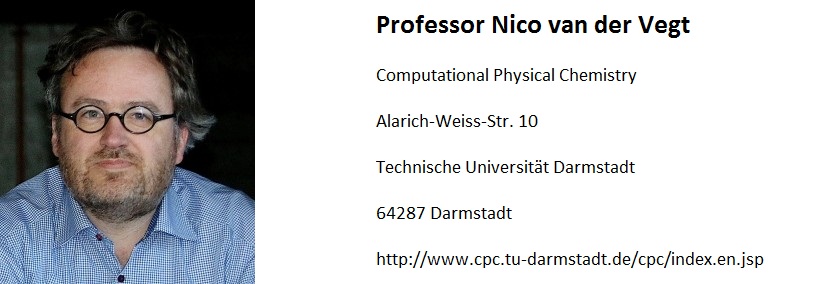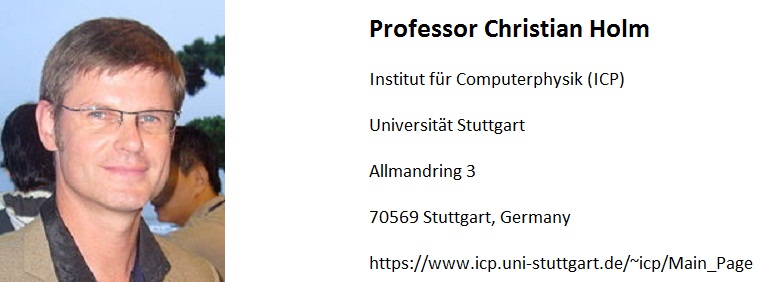
Talks:
Systematic coarse-graining by Iterative Boltzmann Inversion
Abstract
The Iterative Boltzmann Inversion method and related techniques have become a standard protocol for the generation of
coarse-grained (CG) models from atomistic simulations. The CG superatoms typically collect 5-20 real atoms. We present
the method and its derivation. Moreover, we show its current range of application as well as its limitations, for example
representability and dynamics, and how they may be overcome. Applications to polymers, nanocomposites, and complex
fluids are presented.
The particle-continuum gap
Abstract
Combining particle-based models such as molecular dynamics and its variants on the one hand with continuum approaches
such as finite elements on the other hand is still in its infancy. Its difficulty lies in the overlap or handshake region,
where the two completely different descriptions have to be brought together without causing too many and too big
discontinuities. There are a few working protocols in fluid dynamics, and still fewer in structural mechanics. We will
discuss recent strategies and advances in this emerging research field.
----------------------------------------------------------------------------------------------------------------------------

Talks:
Systematic coarse-graining using reversible work potentials
Abstarct
Coarse-grained (CG) models for material specific systems are used in computer simulations to link chemistry and
properties on large time and length scales. We present the Conditional Reversible Work (CRW) method for deriving
CG models from atomistic simulations. In particular, we discuss the range of transferability of CRW-CG models across
different state points and different chemical environments. Applications to modelling bulk molecular liquids, molecular
liquids at interfaces and polymers are discussed.
Dynamically-consistent coarse-grained models
Abstarct
Systematic coarse graining leads to flattening out of rugged potential energy surfaces. The dynamics in CG MD simulations,
therefore, evolves faster than the corresponding dynamics in atomistic simulations. While this is beneficial for sampling
static properties, dynamic properties may be represented incorrectly, for example when coarse-graining affects the rates
of coupled dynamic processes differently. We will discuss the Mori-Zwanzig Dissipative Particle Dynamics approach for
dynamic coarse-graining. This approach accounts for friction and its associated thermal noise to capture the dynamics of
coarse-grained systems.
------------------------------------------------------------------------------------------------------------------------------------------------------------------------------------------

Talks:
Efficient Algorithms for long range interactions
Abstract
In this lecture I will discuss a variety of efficient solvers for long range interactions, notably Coulomb and dipolar
interactions. I will concentrate on the Particle Mesh method P3M, the MMMXD family of solvers for partially periodic
geometries, ELC, and various extensions to solve Coulomb interactions in the presence of dielectric jumps and
inhomogeneities. If time permits some representative applications of these algorithms will be presented.
Simulation of static and dynamic properties of charged polymers
Abstract
Here I will concentrate on how to model charged polymers, with explicit and implicit solvent, atomistic, and coarse-
grained and how to develop better coarse-grained models. We will discuss how to include hydrodynamic degrees of
freedom via the Lattice-Boltzmann method into the implicit solvent models, and present some insights into electrophoresis
and ion transport for various charged polymer systems of interest.





